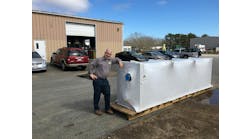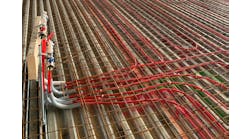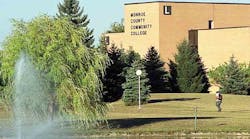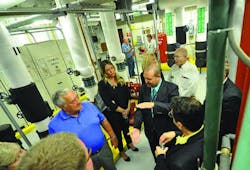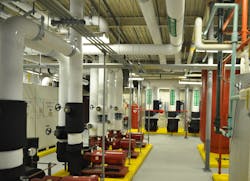MONROE, MICH. — Monroe County Community College (MCCC) officials recently lauded the college’s switchover from an outdated, conventional HVAC system to a much more energy-efficient and sustainable geothermal-based system in five campus buildings totaling approximately 200,000-sq. ft. The geothermal system is all systems go in the Audrey M. Warrick Student Services/Administration Building, Life Sciences Building, Campbell Learning Resources Center and East and West Technology Buildings. The new geo system has the capacity to handle more campus buildings, which will be added in the future.
The opening is the culmination of a nearly two-year, design to completion, $16.1 million project financed by the college over 20 years that has completely transformed the way it heats and cools most of its buildings on its main campus, while providing major cost and environmental benefits.
The choice to make the switch to geo was pretty simple, really. “Do we spend $2-3 million on a conventional HVAC system or $4 million on geothermal — through energy performance contracting — and we have better efficiency, and subsequently, a better return on investment through energy savings?” asked Jack Burns, director of campus planning and facilities, Monroe County Community College
“The college took the initiative to invest in its future and was willing to work with us. This was a unique undertaking for a college of this size,” said Ray Ruiz, construction projects manager, Ameresco, Inc., the engineer and general contractor for the project.
In addition, “the owner had existing ground source heat pump installations in their other buildings that were performing well, and it is one of the most efficient systems available especially when serving multiple buildings with different schedules and heating and cooling loads,” said Trent DeBoer, project engineer, GMB Architecture
In a snapshot, there will be a guaranteed reduction of 160,000 kilowatt hours of energy consumption annually by MCCC, which translates to more than $275,000 in guaranteed savings per year electricity and gas and water costs, and $5.5 million guaranteed savings by MCCC in electricity and gas and water costs over 20 years. Overall, 1,088 metric tons of carbon emissions will be reduced annually.
In with the new
With existing leaky underground piping and an absorption chiller on the fritz, one of the major challenges in the design was fitting new systems into 50-yr.-old buildings. This took some creative use of space and some customized equipment. “This was retrofitting 1968 architecture with 2017 mechanical systems,” says Burns.
The five buildings on campus are served by a closed loop geothermal system with 288, 350-400 ft. deep wells. In all, there is 50 miles of piping. The lifespan of the system’s well field is 50 years, double the lifespan of a conventional system.
“Because retrofits are always more of a challenge than greenfield sites, Ameresco experienced challenges re-utilizing as much of the existing viable HVAC systems as possible while integrating new technology,” says Ruiz.
Another challenge was working with a completely different design idea, says Burns. “We replaced a constant volume system with a variable volume system,” says Burns.
The original equipment consisted of a constant volume reheat system powered by steam boilers and an absorption chiller, which included air compressors and air handlers. It was replaced with three ClimaCool chillers with cooling/heating and geothermal capabilities, five Daikin compact-sized air handling units — reducing the footprint by 50 percent — Bell & Gossett e-80SC pumps with integrated Technologic Variable Frequency Drives (VFDs).
Also, a Lochinvar Crest boiler primarily will be used the first five years of the system’s existence, says Burns, until the well field stabilizes, and then from there it will only be needed for supplemental heat if needed.
Despite such limiting factors as not being able to shut down buildings to complete the installation, the team worked through the adversity. “Ameresco takes pride in collaborating with customers to minimize disruptions throughout the duration of its projects. We were able to complete installation without a single school operations interruption through customer collaboration, creative scheduling, and the utilization of temporary systems,” said Ruiz.
